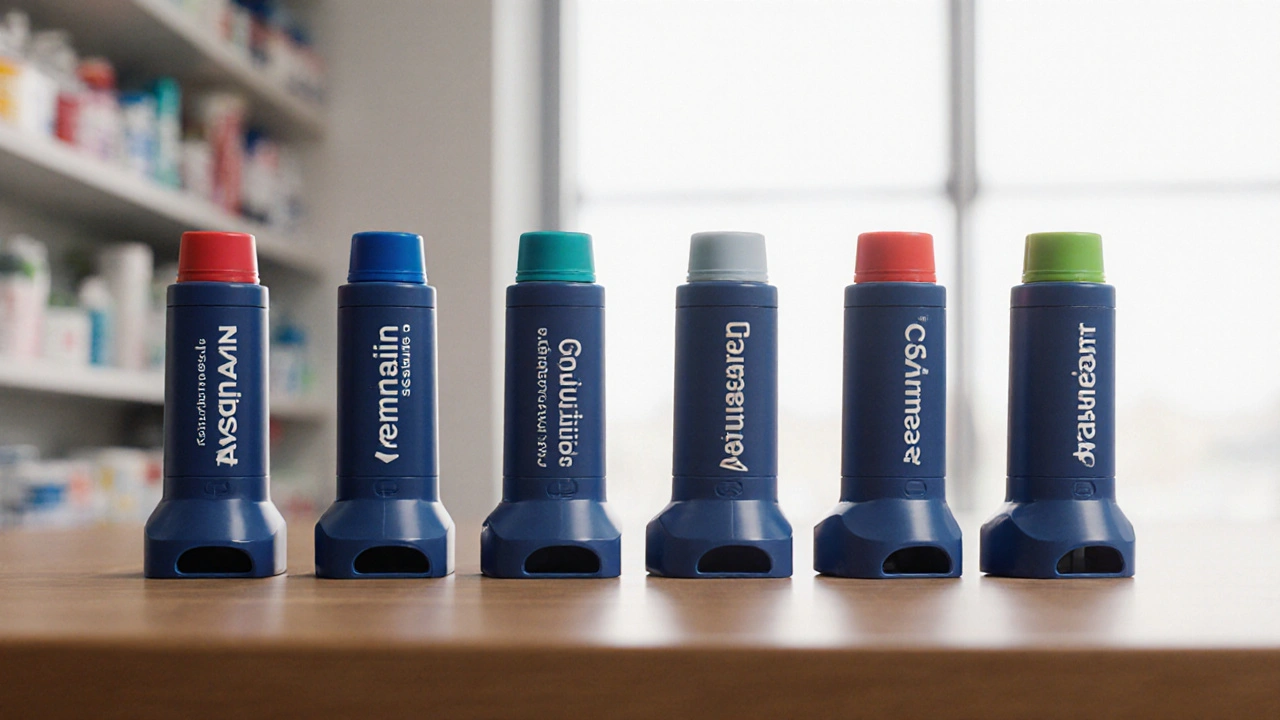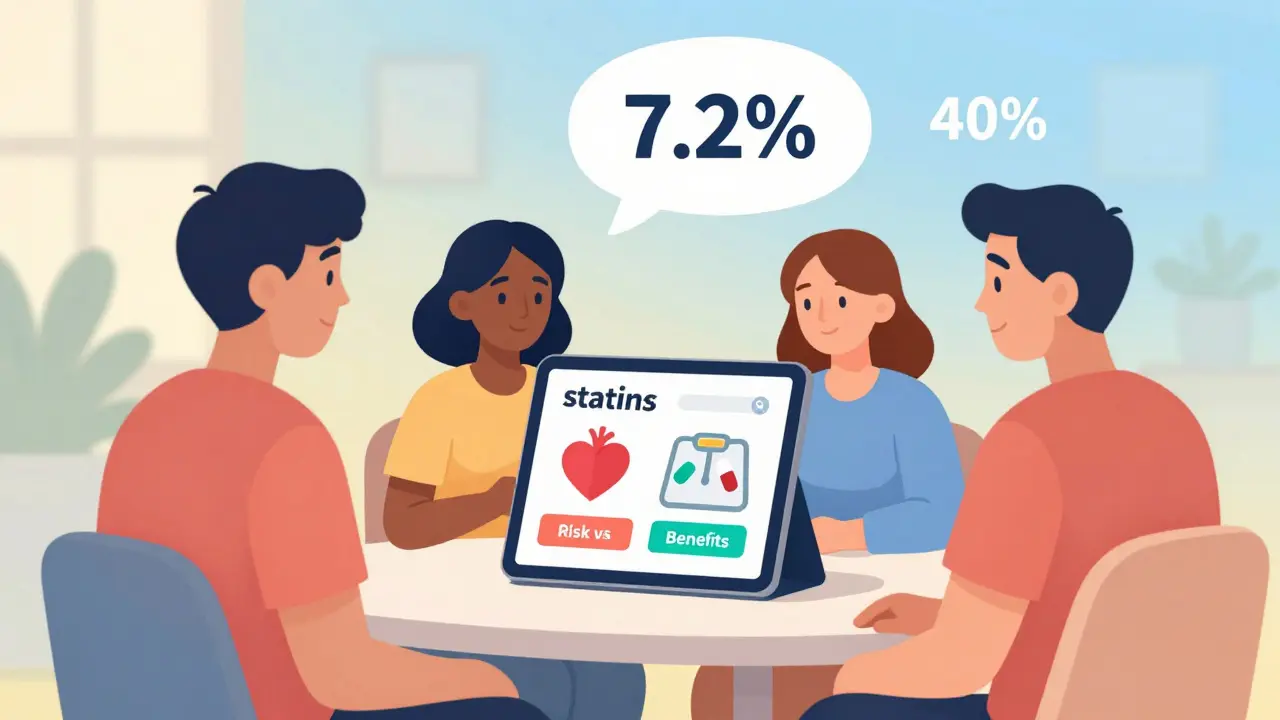Rescue Inhaler Comparison Tool
Select two inhalers to compare their key attributes:
Asthalin Inhaler is a hand‑held, press‑urged metered‑dose inhaler (MDI) that delivers the short‑acting beta2‑agonist salbutamol to relax airway smooth muscle during asthma attacks. In Australia it’s a staple for quick relief, but patients often wonder how it stacks up against other rescue options. This guide walks through the science, key alternatives, and practical tips so you can pick the inhaler that fits your lifestyle and symptom pattern.
Why Salbutamol Works: The Pharmacology in Plain English
Salbutamol (known as albuterol in the United States) binds to beta2‑adrenergic receptors on bronchial smooth muscle. The binding triggers a cascade that increases cyclic AMP, causing the muscle to relax within minutes. The result is a rapid widening of the airways, usually noticeable within 5minutes and lasting up to 4hours.
Because it acts quickly and wears off relatively fast, salbutamol is classified as a short‑acting beta2‑agonist (SABA). This makes it ideal for sudden wheeze, chest tightness, or exercise‑induced bronchoconstriction, but it’s not meant for long‑term control.
Major Alternatives on the Market
Several other SABAs and a few combination inhalers are commonly prescribed. Below are the most frequently mentioned options, each introduced with a brief definition.
Ventolin is a brand‑name MDI containing 100µg of salbutamol per puff, widely used in North America and Europe as a rescue inhaler.
ProAir is a salbutamol MDI approved for rapid relief of bronchospasm, noted for its small device size and low propellant volume.
Albuterol is the US generic name for salbutamol, available in both MDI and nebulizer formulations.
Pulmicort is a dry‑powder inhaler (DPI) containing budesonide, a corticosteroid used for maintenance rather than immediate relief.
Symbicort is a combination inhaler delivering budesonide (anti‑inflammatory) plus formoterol (long‑acting beta2‑agonist), intended for both control and quick relief in certain regimens.
Serevent is a long‑acting beta2‑agonist (LABA) inhaler with salmeterol, providing bronchodilation for up to 12hours but not suitable as a sole rescue medication.
Side‑by‑Side Comparison
| Inhaler | Active Ingredient | Onset (min) | Duration (hrs) | Prescription Status (AU) | Typical Dose per Attack |
|---|---|---|---|---|---|
| Asthalin | Salbutamol 100µg | 5 | 4 | Schedule2 (Pharmacy‑only) | 1‑2 puffs |
| Ventolin | Salbutamol 100µg | 5 | 4 | Schedule2 | 1‑2 puffs |
| ProAir | Salbutamol 100µg | 5 | 4 | Schedule2 | 1‑2 puffs |
| Albuterol (MDI) | Albuterol 100µg | 5 | 4 | Schedule2 | 1‑2 puffs |
| Pulmicort | Budesonide 200µg | 30 | 12‑24 (anti‑inflammatory) | Schedule4 (Prescription) | 2 puffs twice daily |
| Symbicort | Budesonide 80µg + Formoterol 4.5µg | 5 | 12 (LABA) | Schedule4 | 1‑2 puffs as needed + maintenance |
| Serevent | Salmeterol 25µg | 15 | 12 | Schedule4 | 1 puff twice daily (not rescue) |
How to Choose the Right Rescue Inhaler
When you’re weighing Asthalin against its peers, consider four practical factors:
- Device ergonomics: Some users find the smaller ProAir easier to carry, while others prefer Asthalin’s traditional shape.
- Cost & insurance coverage: Generic albuterol MDIs are often cheaper than branded Ventolin, but bulk‑buy programs may make Asthalin the best value.
- Peak flow response: If a patient’s peak expiratory flow improves by >20% after one puff, the inhaler is likely delivering adequate dose.
- Adjunct therapy: For people already on a LABA or inhaled corticosteroid, a combination inhaler like Symbicort might reduce the number of devices they need to carry.
In many Australian clinics, clinicians start with a SABA (Asthalin, Ventolin, or ProAir) and add a maintenance inhaler only if symptoms persist more than twice a week.

Real‑World Scenarios
Scenario 1 - The active runner: Jane, a 28‑year‑old marathoner, experiences exercise‑induced bronchospasm. She carries a compact ProAir because it fits snugly in her running belt, and she uses a spacer to ensure deep lung deposition.
Scenario 2 - The elderly with arthritis: Mr. Liu, 72, finds it hard to press down on a heavy MDI. His pharmacist switched him from Asthalin to a soft mist inhaler (not covered here) that requires less force, but kept the same salbutamol formulation.
Scenario 3 - The child on school grounds: Lily, 10, needs quick relief during recess. Her school nurse prefers a Ventolin unit because the label is universally recognized, reducing confusion during emergencies.
Safety and Common Side Effects
All SABAs share a similar safety profile. Common side effects include mild tremor, racing heart, and throat irritation. Rarely, overuse can lead to tolerance, where the bronchodilator effect blunts, prompting clinicians to add a controller medication.
Important safety tip: If you need more than three puffs in 24hours, it’s a signal to contact your doctor. Repeated high‑dose use may indicate uncontrolled asthma and increase the risk of severe exacerbations.
Connected Topics: Where Asthalin Fits in the Bigger Picture
Understanding Asthalin’s role becomes easier when you map it to related concepts:
- Bronchodilator classes: SABA (Asthalin, Ventolin) vs. LABA (Serevent, Formoterol).
- Controller vs. reliever: Inhaled corticosteroids (Pulmicort) control inflammation; SABAs relieve acute symptoms.
- Asthma action plan: A written plan typically lists the rescue inhaler (e.g., Asthalin) and steps for escalating care.
Exploring these adjoining topics will help you decide whether a single rescue inhaler suffices or a combination strategy is smarter.
Next Steps for Readers
If you’re currently using Asthalin, ask your GP or pharmacist the following:
- Does my device deliver the correct dose (check the dose counter)?
- Would a spacer improve lung deposition for my technique?
- Is there a cost‑effective generic (albuterol) that matches my needs?
- Should I consider adding a low‑dose inhaled corticosteroid for better overall control?
Answers to these questions will guide you toward the most suitable inhaler, whether you stay with Asthalin or switch to an alternative.
Frequently Asked Questions
Is Asthalin the same as Ventolin?
Yes. Both contain 100µg of salbutamol per puff and work within minutes. The difference is mainly branding and packaging; clinical efficacy is identical.
Can I use a single inhaler for both rescue and maintenance?
Only certain combination inhalers, like Symbicort, are approved for both purposes. Pure SABAs such as Asthalin are intended solely for quick relief. Mixing roles can mask uncontrolled asthma.
What should I do if my inhaler feels empty but the dose counter says otherwise?
Check the spray pattern. If the mist is weak or sputters, the propellant may be low. Replace the inhaler or contact the pharmacy for a replacement, especially if you rely on it for emergencies.
Are there any age restrictions for using Asthalin?
Asthalin is approved for children six years and older. For younger children, a nebulized solution or a pediatric‑specific MDI with a spacer is recommended.
How does a spacer improve the effectiveness of a rescue inhaler?
A spacer holds the aerosol cloud, allowing larger particles to settle before inhalation. This reduces oropharyngeal deposition, increases lung delivery, and is especially useful for children or adults with poor coordination.







Louie Lewis
September 26, 2025 AT 12:53Salbutamol is the silent workhorse of modern therapeutics, quietly dictated by unseen forces that shape formularies.
Eric Larson
September 27, 2025 AT 02:46Wow! This tool lets you stack Ventolin, ProAir, and Asthalin side‑by‑side-so why settle for one?? The onset times are practically identical, but the subtle device ergonomics can make a world of difference!!!
Kerri Burden
September 27, 2025 AT 16:40When evaluating short‑acting beta‑agonists, clinicians routinely consider pharmacodynamic onset, receptor affinity, and device actuation mechanics. The salbutamol molecule exhibits a high selectivity for β2‑adrenergic receptors, resulting in rapid bronchodilation within minutes. Comparative studies have demonstrated that Asthalin, Ventolin, ProAir, and generic albuterol share virtually identical dose‑response curves when delivered via metered‑dose inhalers. However, subtle differences emerge in plume geometry, which can affect oropharyngeal deposition and consequently lung bioavailability. Particle size distribution, typically measured in microns, dictates the fraction of drug that reaches the lower airways; most modern SABAs target a mass median aerodynamic diameter of 1–3 µm. Spacer devices mitigate coordination challenges and improve deposition efficiency by allowing aerosol settling prior to inhalation. In asthma action plans, a threshold of three puffs within 24 hours often signals suboptimal control and warrants escalation to controller therapy. The cost differential between brand‑name Ventolin and generic albuterol can be substantial, especially in health systems lacking bulk‑purchase agreements. Insurance formularies may prioritize schedule‑2 pharmacy‑only products, influencing patient adherence. From a pharmacoeconomic perspective, the incremental cost‑effectiveness ratio favors generic options when clinical outcomes are comparable. Real‑world adherence data suggest that device size and portability significantly impact patient willingness to carry a rescue inhaler during physical activity. For pediatric populations, the use of a spacer or valved holding chamber is strongly recommended to reduce throat deposition and improve dose consistency. Regarding safety, supratherapeutic use can precipitate tachycardia, hypokalemia, and paradoxical bronchospasm, underscoring the importance of patient education. The global regulatory landscape classifies salbutamol as a Schedule 2 medication in many jurisdictions, permitting over‑the‑counter purchase in some countries while requiring prescription in others. Ultimately, the choice of inhaler should be individualized, integrating clinical efficacy, device ergonomics, cost, and patient preference into a shared decision‑making process.
Joanne Clark
September 28, 2025 AT 06:33Asthalin may appear mundane, but its pharmacologic elegance is absolutely defnitely superior to those generic impostors.
George Kata
September 28, 2025 AT 20:26I hear you, Eric-device ergonomics can feel like a personality clash, so finding the right grip really does matter.
Nick Moore
September 29, 2025 AT 10:20Don't forget that any reliable SABA will get you through an attack, and a little optimism about your inhaler choice can make the whole process less stressful.
Jeffery Reynolds
September 30, 2025 AT 00:13It is essential to recognize that the active ingredient is identical across brands; therefore, any claim of superiority based solely on branding is unfounded and detracts from evidence‑based practice.
Mitali Haldankar
September 30, 2025 AT 14:06Sure, everyone says the cheapest generic is fine 😏, but have you considered that the propellant composition might be subtly engineered to favor certain manufacturers? 🤔
snigdha rani
October 1, 2025 AT 04:00Oh great, another table of numbers. Because that's exactly what I needed when I'm out of breath.
Mike Privert
October 1, 2025 AT 17:53Remember, mastering inhaler technique is as important as the medication itself; practice with a spacer, count your breaths, and keep a fresh device on hand.
Veronica Lucia
October 2, 2025 AT 07:46In the grand scheme, a rescue inhaler is simply a tool-a temporary bridge between crisis and calm, reminding us of the delicate balance between control and freedom.
Sriram Musk
October 2, 2025 AT 21:40From a clinical standpoint, the comparative efficacy of salbutamol inhalers is substantiated by numerous double‑blind trials, yet individual patient factors remain pivotal in the final selection.
allison hill
October 3, 2025 AT 11:33While the data sheets all look the same, there is an undercurrent of industry influence that quietly nudges prescribers toward certain brands, a fact worth scrutinizing.
Tushar Agarwal
October 4, 2025 AT 01:26Good info! 🙂